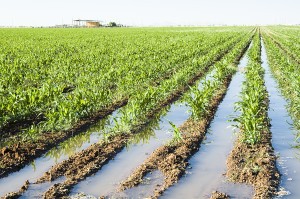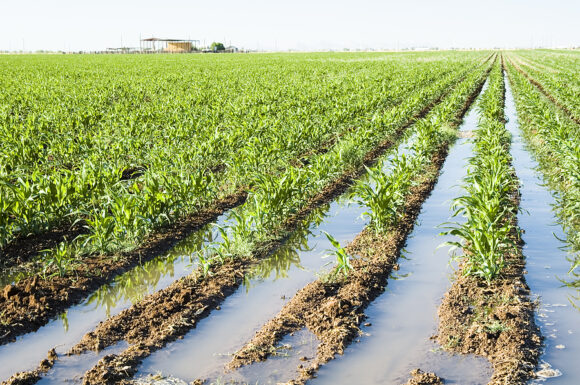Last year’s drought has contributed to confusion over crop insurance rules for some Upper Midwest farmers who couldn’t get a crop in the ground this past spring due to the opposite weather extreme – too much moisture.
Some farmers are worried they won’t qualify for insurance payments this year on cropland that was too wet to plant. The government acknowledges the confusion and says it is committed to clearing it up, but federal officials also say some farmers are misinterpreting an informational memo that went out a year ago.
Members of North Dakota’s congressional delegation and farmers in the state – where the confusion and potential impact appear to be most pronounced – are urging the federal Agriculture Department’s Risk Management Agency to clear up the matter once and for all. Agency Administrator Brandon Willis plans to come to North Dakota sometime in August to meet with producers about the issue, according to Sen. John Hoeven, R-N.D.
“It’s been a big concern for our farmers,” Hoeven said.
 At issue is a rule affecting whether farmers qualify for “prevented planting” payments – crop insurance payments for land that is too wet or dry to plant. To prevent fraud, farmers are barred from collecting the payments on land that has experienced prolonged flooding and typically can’t support crops.
At issue is a rule affecting whether farmers qualify for “prevented planting” payments – crop insurance payments for land that is too wet or dry to plant. To prevent fraud, farmers are barred from collecting the payments on land that has experienced prolonged flooding and typically can’t support crops.
After a string of wet years in the Upper Midwest that left potentially productive farmland a soupy mess, officials and farmers in 2011 pushed the Risk Management Agency to ease that provision. The agency implemented a rule effective last year under which farmers in the Dakotas, Montana, Minnesota and Iowa can qualify for prevented planting payments on flooded land if they have planted a crop there at least once in the previous four years – commonly known as the one-in-four rule – proving the land can be productive.
Many farmers in North Dakota who couldn’t plant this past spring were able to seed a crop in drought-plagued 2012, but they worry that won’t count toward meeting the one-in-four rule requirement because of a July 2012 Risk Management Agency memo. It refers to an “abnormally dry” year, which doesn’t count under the one-in-four rule because prevented planting payments aren’t meant to go toward land that is farmable only under abnormal conditions.
“Crop insurance adjusters and farmers are concerned about the lack of direction provided by RMA regarding what constitutes normal precipitation,” said Sen. Heidi Heitkamp, D-N.D.
Hoeven said Willis has assured him that 2012 will not automatically be considered an abnormally dry year across the region – that insurance claims will be dealt with on a case-by-case basis. RMA officials say that is nothing new, and that farmers have misinterpreted the July 2012 memo. Farmers dispute that.
“There was no misinterpretation,” said Dan Wogsland, executive director of the North Dakota Grain Growers Association. “That memorandum said you could not count 2012 because, in RMA’s words, it was abnormally dry. That was a blanket statement that we said from the beginning was wrong.
“It’s good to see that RMA has backed off its initial response,” he said. “But RMA still hasn’t come to the full realization that 2012 is a year that should be totally counted in North Dakota. We’re encouraged to see they’re making strides.”
Wogsland said that requiring farmers to prove that it was not “abnormally” dry on their farmland last year before they can collect insurance for unplanted ground this year “is making people jump through more hoops that are needless. Needless bureaucracy.”
The Risk Management Agency will not say that 2012 should be automatically counted toward the one-in-four rule because it is up to insurance providers – not the agency- to determine a farmer’s eligibility, officials said.
“Producers should work with their insurance agents on a case-by-case basis to make the determination regarding prevented planting claims,” agency spokesman John Shea said.
However, Shea said the agency is willing to work on a better definition of “normal” weather conditions, to ensure a similar issue does not arise in the future.
“RMA is committed to finding a solution that provides more clarity to farmers and (insurance) companies, and that protects taxpayers moving forward,” he said.
North Dakota had an extremely wet spring. The Risk Management Agency does not yet have figures on the amount of unseeded cropland, but the Federal Farm Service Agency estimates it at 4.4 million acres – not far from the 2011 record of 5.6 million acres.
Though the RMA won’t declare that 2012 can be a one-in-four year, it’s not automatically excluding it, either – something Hoeven said “solves it for most of our farmers.”
“We’ve brought common sense to the determination of who is eligible for prevented plant this year,” the senator said. “It’s important now that we get some clarity on the rule going forward.”
Was this article valuable?
Here are more articles you may enjoy.


 NYC Sues Delivery App Over Lost Pay in New Mamdani Crackdown
NYC Sues Delivery App Over Lost Pay in New Mamdani Crackdown  US Lawmaker Unveils Bill Requiring Manual Car-Door Releases
US Lawmaker Unveils Bill Requiring Manual Car-Door Releases  Musk’s X Probed by UK Over Grok’s Thousands of Sexualized Images
Musk’s X Probed by UK Over Grok’s Thousands of Sexualized Images  The Return Period for An LA Wildfire-Scale Event May Be Shorter Than You Think
The Return Period for An LA Wildfire-Scale Event May Be Shorter Than You Think 